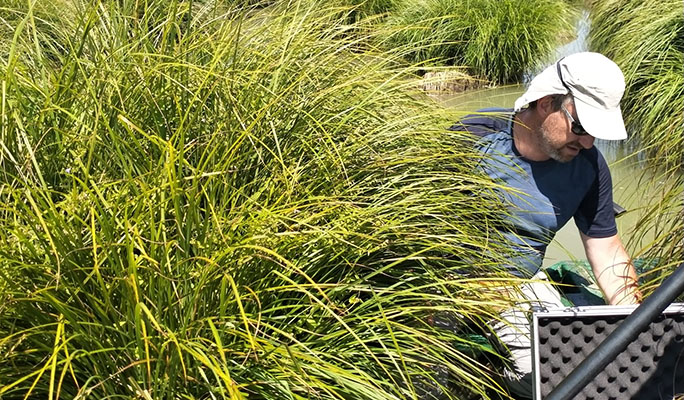MacroDIVERSITY, for aquatic and marshland plants

photo: (cariceto a Carex elata, Lake of Chiusi, Tuscany, July 2020)
Freshwater biotopes
Humid freshwater environments are like real hot-spots of plant biodiversity, and at the same time habitats in a critical state of conservation: numerous are the threats to these environments, in many cases progressively degraded or even disappeared. Since past times, the scientific world has shown great interest in biodiversity linked to freshwater biotopes, as evidenced by the high number of naturalistic finds preserved in the Museum of Natural History of Florence: in some cases, they are the testimony of species that were once common and today rarefied or disappeared from entire territories.
New analytical techniques
The study of aquatic and marshy plants (macrophytes), their ecology and their relationships, has benefited from the new analysis techniques that have developed in recent years. Among these, spectroscopy by means of remote surveying has demonstrated great potential in vegetation mapping and in the evaluation of various ecological processes. Techniques based on the use of molecular markers for phylogenetic analysis have instead paved the way for new ways of measuring biodiversity, evolutionary processes and speciation, as well as defining conservation priorities.
Research Project of Considerable National Interest
The macroDIVERSITY project starts from the hypothesis that phylogenetic and spectral diversity, suitably calibrated and integrated, can be used to map the functional traits and characterize the functional diversity of macrophages, with a relatively low effort and high coherence.
The study areas are very different environments, both for biogeographical characteristics and for different trophic gradients. Field activities are numerous, from spectral measurements to floristic herborizations, from samples for genetic analysis to those for the study of functional traits.
In 2020 investigations were carried out at the lakes of Massaciuccoli and Chiusi in Tuscany and in those of Bracciano and Martignano in Lazio. Through field trips the researchers of the Museum of Natural History have also collected several finds, in some cases the first acquisitions for the region of Lazio in the Central Herbarium.
"Merging spectral and phylogenetic diversity to assess macrophyte trails and functions along multiple gradients (macroDIVERSITY)", the extended title of the PRIN -MIUR 2017 project, sees the participation of the Museum of Natural History of the University of Florence through a collaboration agreement with the Department of Biology (BIO). In addition to the researchers of the BIO Department of the University of Florence, the project also includes those of the Department of Chemical Sciences, Life and Environmental Sustainability of the University of Parma and the Institute for Electromagnetic Environmental Detection of the National Research Council (CNR).
Publications
(1) Castellani M.B., Bolpagni R., Coppi A., Dalla Vecchia L., Lastrucci L., Villa P., 2021. An evolutionary approach for the study of spatial diversity of freshwater macrophytes in Central and Northern Italy. Atti Riunioni Scientifiche. Notiziario della Società Botanica Italiana, 5 (2): 117.
(2) Castellani M.B., Lastrucci L., Lazzaro L., Bolpagni R., Dalla Vecchia A., Coppi A., 2022. The incidence of alien species on the taxonomic, phylogenetic, and functional diversity of lentic and lotic communities dominated by Phragmites australis (Cav.) Steud. Knowl. Manag. Aquat. Ecosyst. 2022, 423, 5. https://doi.org/10.1051/kmae/2022001
(3) Castellani M.B., Coppi A., Bolpagni R., Gigante D., Lastrucci L., Reale L., Villa P., 2023. Assessing the haplotype and spectro-functional traits interactions to explore the intraspecific diversity of common reed in Central Italy. Hydrobiologia 850(4), pp. 775–791. https://doi.org/10.1007/s10750-022-05124-z
(4) Castellani M.B., Dalla Vecchia A., Bolpagni R., Natale R., Piaser E., Lastrucci L., Coppi A., Villa P., 2023. Genetic drift vs natural selection affecting the evolution of spectral and functional traits of two key macrophytes: Phragmites australis and Nuphar lutea. Freshwater Biology 68:1739–1750. doi: https://doi.org/10.1101/2023.06.19.545543
(5) Dalla Vecchia A., Coppi A., Castellani M.B., Lastrucci L., Piaser E., Villa P., Bolpagni R., 2024. Multidimensional trait variability in a widespread, Paleoarctic macrophyte: functional, spectral and genetic drivers. Oikos 2024: e10047. doi: 10.1111/oik.10047
SMA contact person: Lorenzo Lastrucci
Last update
12.03.2024
